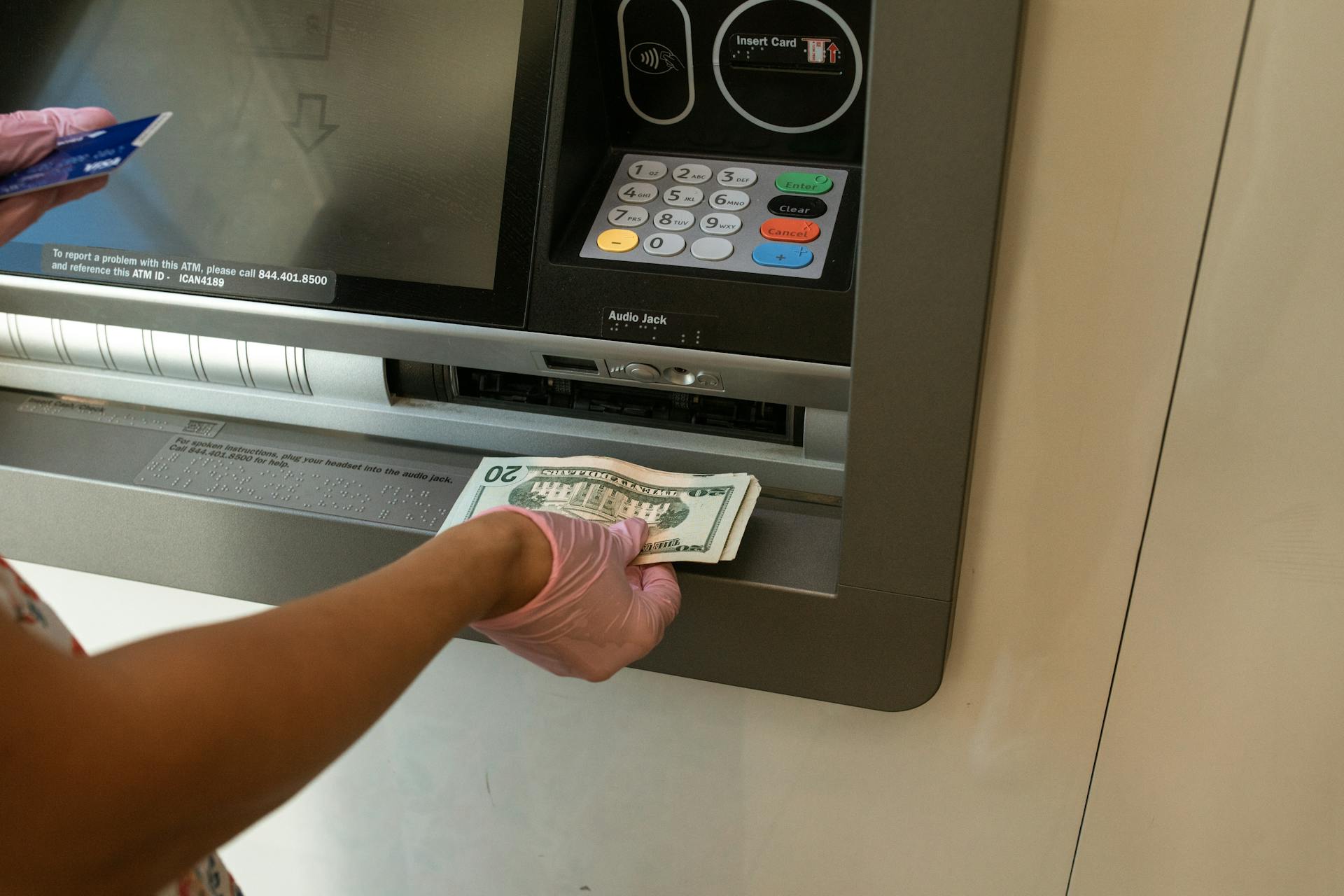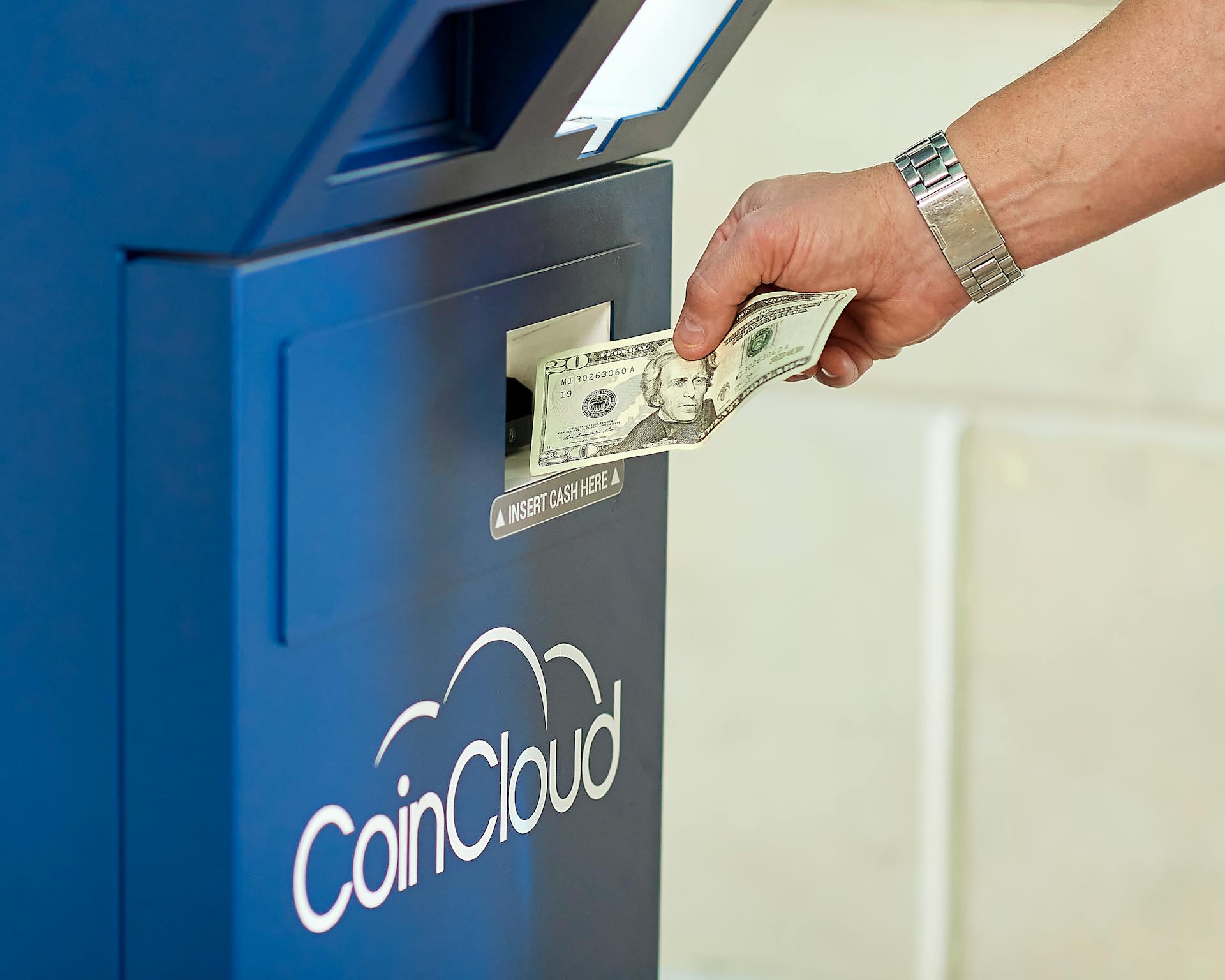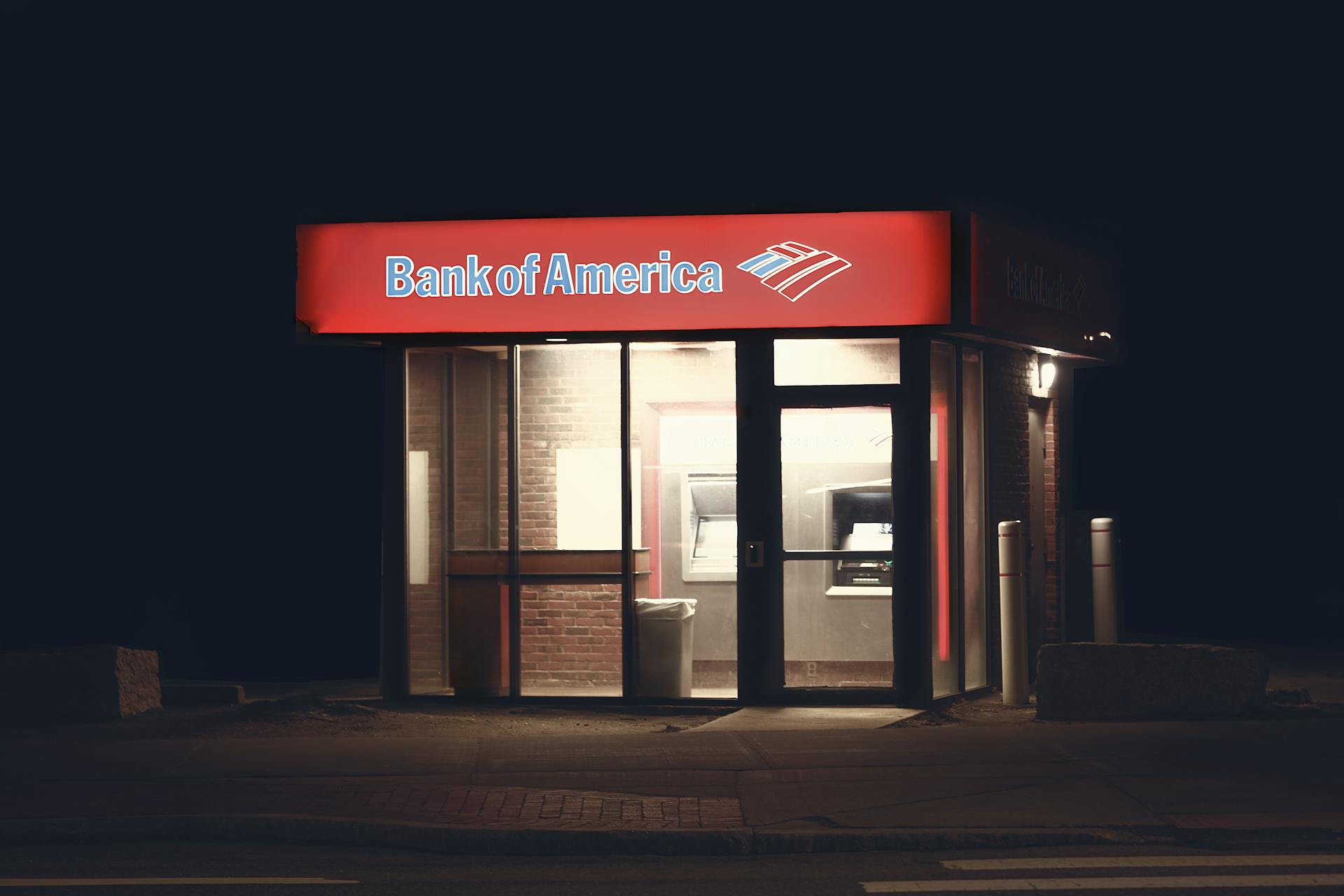
A payroll ATM card is a type of debit card that allows employees to access their earned wages before payday.
It's essentially a prepaid card that's loaded with funds from your employer's payroll system.
Some payroll ATM cards come with a fee for ATM withdrawals, while others may have a monthly maintenance fee.
You can use a payroll ATM card to make purchases online or in-store, pay bills, and even get cash back at certain retailers.
Typically, payroll ATM cards are linked to your employer's payroll system, so you can access your funds as soon as they're deposited.
You can also check your card balance and transaction history online or through a mobile app.
You might enjoy: How to Use Wells Fargo Atm without Card
What is a Payroll ATM Card?
A payroll ATM card is just another name for a payroll card, which is a type of financial product offered by some employers to their employees.
Some payroll cards come with a perk: one or more free in-network ATM withdrawals per pay period. This can be a convenient option for employees who need to access their money quickly.
Employees can locate in-network ATMs online, often through the same website where they log in to their card account. This makes it easy to find an ATM that won't charge them extra fees.
Explore further: Mark Cuban Gives Employees Money
Benefits of Payroll ATM Cards
Payroll ATM cards offer numerous benefits to employees and employers alike. They promote financial wellness by providing employees with the tools they need to budget and save.
Employees can access their pay without having to open a bank account, making payroll cards a valuable financial instrument for unbanked or underbanked employees.
Payroll card payments are secure, reducing the risk of financial loss. This is especially important for remote teams or temporary employees who may not have access to traditional banking services.
Compared to other payment methods, payroll cards come with lower administrative costs for processing payroll. This can be a significant cost savings for businesses.
Money transferred to the payroll card is accessible almost instantly, giving employees quick access to their earned wages.
Here are some key benefits of payroll ATM cards:
By offering payroll ATM cards, businesses can provide their employees with a convenient and secure way to access their earned wages.
Direct Deposit vs Payroll ATM Cards
Direct Deposit is a convenient option for employees working remotely, as it can be handled automatically and funds are available as soon as the next business day.
However, it's not available for employees without a bank account. In these cases, a payroll card is the next best option.
Payroll cards work similarly to debit cards, containing the exact amount that would have been direct deposited. Some providers charge fees for balance inquiries and cash withdrawals, but there are ways to avoid fees depending on your provider.
Direct Deposit offers several benefits, including saving time for employees by eliminating paper checks. But payroll cards provide an advantage for employees without a bank account, making them a viable alternative.
Related reading: How to Deposit Check at Atm without Card
Direct Deposit vs
Direct deposit is a convenient payment method for employees, but it's not available if a business owner is paying an individual without a bank account.
Direct deposit can be handled automatically and funds are available as soon as the next business day, making it a time-saving option for employees.
Discover more: Nc State Employees Dental Insurance
However, some employees may not have access to a bank account, which is where payroll cards come in as a reliable alternative.
Payroll cards are prepaid, reloadable cards that work like a debit card, containing the exact amount that would have been direct deposited.
The average unbanked employee spends $182 annually just to access their pay and pay their bills, making payroll cards a cost-effective solution.
Some payroll card providers may charge fees for balance inquiries and cash withdrawals, but there are ways to avoid these fees depending on the provider.
Additional reading: Atm Card Foreign Transaction Fees
What Is the Difference Between Debit Cards and Credit Cards?
Debit cards require opening an account with the respective bank that issues the card, but payroll cards function without a separate account.
The main difference between debit cards and credit cards is that debit cards withdraw money directly from your account, whereas credit cards allow you to borrow money from the issuer.
Payroll cards and debit cards function similarly, providing access to money deposited with a financial institution.
You can think of debit cards as a direct link to your account, whereas credit cards are like a loan that you need to pay back with interest.
Intriguing read: Atm Card Can Be Used to Withdraw from Checking Account
Employee
Having a payroll ATM card can be a game-changer for employees. It allows them to have their wages direct deposited to their card every payday, giving them instant access to their money.
Employees can use their payroll card just like a debit card, making purchases at online and offline stores, withdrawing money from ATMs, and covering bill payments. They can also check the balance of their pay card using an online portal, email, text, or mobile app.
With a payroll card, employees can earn rewards, such as cash back at participating grocery and convenience stores. This can help them save money and make the most of their hard-earned wages.
Payroll cards don't let employees overdraft from their accounts, preventing them from paying overdraft fees for spending money they don't have. This helps them manage their finances more effectively and avoid unnecessary expenses.
Some payroll cards offer employees access to a portion of their earned wages before payday, which can help them make ends meet in between pay periods. For example, a card provider might let employees withdraw up to 50% of their next paycheck during the middle of a pay period.
Recommended read: What Are Tax Deferred Wages
Employees can also create savings accounts with some card issuers, which can support their financial wellness. This is a great way to encourage employees to save for the future and build a safety net.
Here are some benefits of payroll cards for employees:
- Convenience: Employees can use pay cards just like debit cards.
- Instant access to wages: Employees can access their wages immediately, without having to deposit or cash a traditional check.
- Rewards: Pay cards give employees benefits and rewards, like cash back at participating stores.
- Better financial management: Pay cards help employees prevent overdraft fees and manage their finances more effectively.
- Earned wage access: Some pay cards offer employees access to a portion of their earned wages before payday.
- Savings accounts: Some card issuers enable cardholders to create savings accounts.
Regulations and Compliance
Payroll ATM card regulations can be complex, but understanding the basics can help you navigate the process.
Federal regulations require you to ensure that employees make more than the minimum wage after fees are deducted. This means you'll need to adjust your pay rate if you're using a pay card with fees that lower their wages below the minimum threshold.
Some states have additional regulations in place, including requirements for employee consent to using a reloadable pay card, the ability to withdraw the entire wage amount without fees, and disclosure of card usage fees.
To comply with state regulations, you can check out state-specific requirements regarding payroll debit cards. This will help you determine which regulations apply to your business.
A different take: Third Party Administrator Fees
Federal Regulations
Federal regulations regarding pay cards are in place to ensure employees are treated fairly. Employees can be affected by pay card usage fees that lower their wages below the minimum threshold.
If you pay your employees the federal minimum wage of $7.25 per hour using a pay card with a monthly account maintenance fee of $5.25, their total income will be below minimum wage. You'll need to adjust your pay rate to ensure they still receive $7.25 per hour after the monthly fee is deducted.
Some pay card fees can add up quickly, so it's essential to monitor them closely. Federal regulations require you to ensure your employees make more than the minimum wage.
If you're unsure about federal pay card regulations, you can check out resources that outline the rules and guidelines.
Recommended read: Bank with No Foreign Atm Fees
Can You Overdraft?
You can't overdraft a payroll card because it's a type of debit card based on a prepaid system. This means employees can only spend the amount loaded onto the card by the employer with the last payroll run, plus any existing balance from the last pay period.
A different take: Compare Payroll and Prepaid Cards to Debit and Credit Cards
Payroll cards don't allow for acquiring debt like a credit card. They're designed to provide a secure way for employees to receive their pay without the risk of overspending.
The prepaid system ensures that employees can't spend more than what's available on the card. This eliminates the possibility of overdrafting and the associated fees.
Setting Up and Using a Payroll ATM Card
Setting up a payroll ATM card is a straightforward process that can be completed in just a few steps. You can use a payroll card, also known as a payroll ATM card, as a debit card without needing a checking account.
To start, you'll need to enroll in the program, which is usually done through your employer. They'll provide you with a card that you can use to access your money. Some payroll cards offer one or more free in-network ATM withdrawals per pay period.
You can locate in-network ATMs online or ask your employer for a list. Once you've activated your card, you can use it to make purchases, withdraw cash, or shop online. Payroll cards are accepted in any place that accepts debit card payments.
To activate your card, you'll need to download the Payactiv app, create an account, and follow the prompts. You'll need your Employee ID, which can be found on your pay stub. With a payroll ATM card, you can access your money immediately, making it a convenient option for managing your finances.
For another approach, see: Do I Need Disability Income Insurance
Frequently Asked Questions
What is the difference between a payroll card and a debit card?
A payroll card operates with a separate account, unlike a debit card which is linked to a bank account. This key difference sets payroll cards apart from traditional debit cards.
What is a disadvantage of a payroll card?
A disadvantage of a payroll card is that it does not earn interest and may incur additional fees. Additionally, payroll cards can be lost or stolen, posing a risk to your funds.
Can I get a debit card for my employees?
Yes, employers can provide payroll debit cards to their employees as a convenient alternative to traditional paychecks. This can be especially helpful for employees without bank accounts, who can avoid check cashing fees and other banking costs.
Can I put my paycheck on a prepaid card?
Yes, you can deposit your paycheck directly onto a prepaid card. Consider directing depositing all or some of your paycheck to a Visa Prepaid card for easy and convenient access to your funds.
Sources
- https://www.pacificpayrollgroup.com/payroll-cards/
- https://www.hourly.io/post/payroll-card
- https://ucbbank.com/business/planning/endowment-management/payroll-cards
- https://www.payactiv.com/blog/what-is-a-payroll-card-and-how-does-it-work/
- https://www.lano.io/blog/what-is-a-payroll-card-and-how-does-it-work
Featured Images: pexels.com


